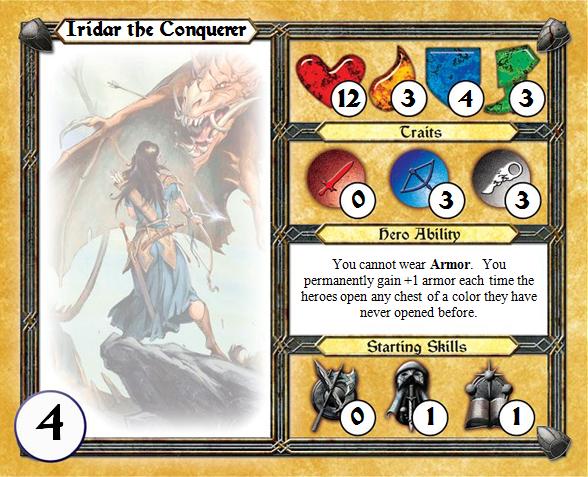
Hero of the Week
A new custom hero design for Descent: Journeys in the Dark each week, created with a hero generator and point-buy editor of my own design. This is basically just an excuse for me to play around with my own tool.
Heroes are designed to be balanced for "vanilla" games; some may generate problems in advanced campaigns.

November 7, 2010 - Iridar the Conquerer
Comparisons to Nanok of the Blade are natural here. Iridar has the same starting the maximum armor as Nanok, but scales up automatically based on chest level instead of "whenever he has enough money", which is probably in Iridar's favor early on (the heroes probably open a copper chest significantly before Nanok has 500 coins to drop on training), but could possibly swing in Nanok's favor towards the end of some quests (particularly if they don't have gold chests).
Iridar's balance ranged and magic traits actually means that he benefits less from training than most heroes, where Nanok benefits more, but gives Iridar a solid attack at the start of a quest and flexibility in the face of treasure draws, including the ability to wield rune weapons despite his thick armor. Distance weapons help compensate for low speed and fatigue.
But he's down a skill, and compared to Nanok has lower wounds, fatigue, and speed. Of course, Nanok is probably one of the stronger official heroes, and thus above our power benchmark, so that seems pretty reasonable. It's a shame Iridar couldn't also have high speed, to further abuse the benefits of heavy armor without the usual drawbacks, but one can't have everything.
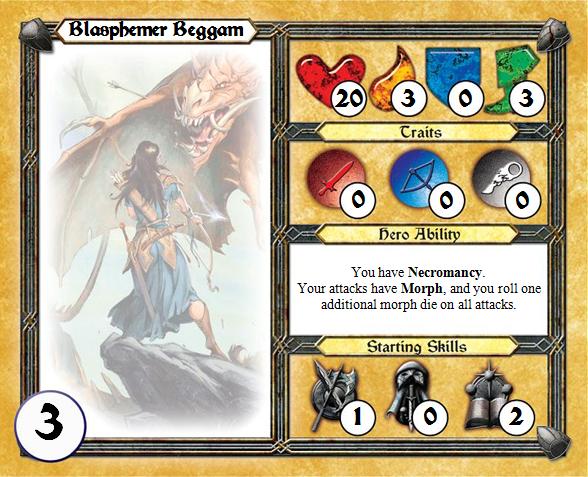
October 31, 2010 - Blasphemer Beggam
Stay inside, child. Blasphemer Beggam is awake tonight. He roams the countryside with a ponderous slowness, seeking out any foolish enough to wander across his path. He can shrug off blows that would kill someone still human. Then the weapons he carries take on strange forms, lashing out with unnatural tendrils or unholy power, sucking the life from his hapless victims. In his wake, the dead rise and shamble after him, ripping apart any living thing that gets too close, before they crumble back to the ground.
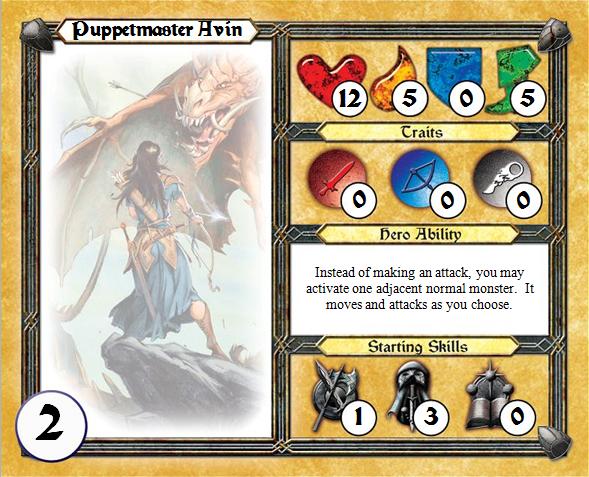
October 24, 2010 - Puppetmaster Avin
Puppetmaster Avin is designed to rely primarily on his ability for inflicting damage, rather than using weapons. Controlled monsters will generally do less damage than a well-equipped hero, but one beastman can kill another with an average hit, and the occasional high-tier monster can cause some serious damage. Since the monster both moves and attacks, Avin's ability will occasionally permit an attack on a monster that is otherwise too well-protected, and allows the heroes to rearrange monsters to some extent, with all the tactics that entails.
With 5 speed, 5 fatigue and 3 subterfuge skills, Avin is also an excellent runner. Dual shields are an obvious choice, since weapons aren't required. The combat skill gives Avin a shot at something that allows more attacks per turn, which funnel into the ability; it's also useful because melee is the obvious choice if Avin is forced to make a conventional attack, since it has the highest damage of the three attack types.
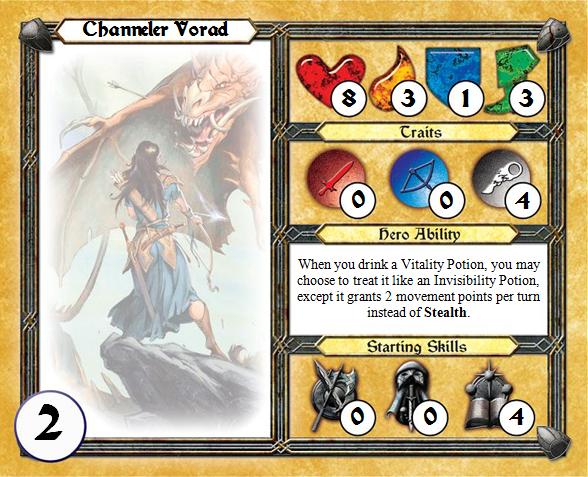
October 17, 2010 - Channeler Vorad
Vorad has strong traits and skills, at expense of his speed and fatigue. However, his ability helps with his mobility, providing an economical way to get extra movement points - six per potion, on average. With infinite money, he'd still gain more per turn by using the vitality potions normally, but it's a reasonable compromise between movement and cost, especially for someone with low fatigue to begin with.
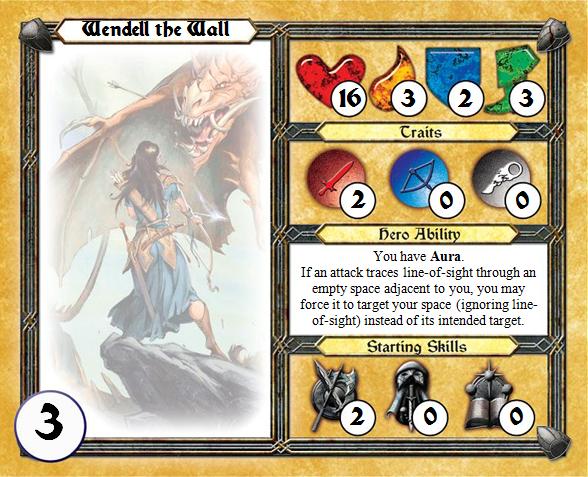
October 10, 2010 - Wendell the Wall
Wendell's role is obvious: his strong defenses and low conquest value make him an unappealing target for the overlord, but his abilities make it hard to target anyone behind him. In a 2- or 3-space wide area, he can completely screen allies standing behind him from (normal) attacks and force any enemy determined to push past him to take 3 Aura damage to get a clear shot.
In exchange, he gives up a trait die and a skill. That leaves him offensively weak, but melee weapons tend to do the most damage, so he should still be able to kill things. He faces a hard choice between starting with an Axe (for maximum damage, to offset his missing die and skill), a Walking Stick (to offset his low speed and maximize his positioning options) or a shield (to maximize his damage-soaking ability).

October 3, 2010 - Lilly Lightningstep
Lilly has no trait dice, but has the Bleed ability, which adds the same average damage as 2 trait dice when a surge is worth a damage. Of course, it's still generally much worse than two trait dice; it's more variable, it can't add range, it won't help you to immediately remove a monster that's in your way, and you won't know that you're one damage short of a kill until it's far too late to buy more dice with fatigue. Still, it means she can dish out respectable damage with any attack type.
Her main ability is a sort of inversion of a Rest order; while a Rest allows one to spend a half-action on the current turn to (maybe) refill fatigue on the next turn, Lilly can refill her fatigue immediately at the cost of (maybe, if she lives) losing a half-action on her next turn. If she uses it every round, she can effectively "Advance" with a "speed" of 7, the option to carry excess movement into her next turn (or spend it on power dice) and an effective immunity to being stunned (since multiple tokens only increases the duration). That's pretty impressive, but it costs her the option of attacking twice in a turn; she's probably better off planning ahead and avoiding its use on some rounds (particularly before revealing a new area) so that she can take a full action occasionally.
Lilly has also given up the option of using vitality potions to refill her fatigue, but her unusual traits mean that power potions are actually pretty good for her, adding a full 5 power dice (on top of her Bleed) with any attack type. And with her fatigue-restoring ability, she can still potentially move 20 spaces in a single turn - even while wearing heavy armor, and without using up potions. Compared to other runners, she's pretty expensive to lose, but also exceptionally well-armored; with Plate Mail and a Ring of Protection (6 armor total), she might be able to simply ignore the attacks of many monsters.
(From a point-buy perspective, she could keep the ability to use vitality potions if she reduced her fatigue by one; I suspect that build is actually a bit better overall, but less interesting.)
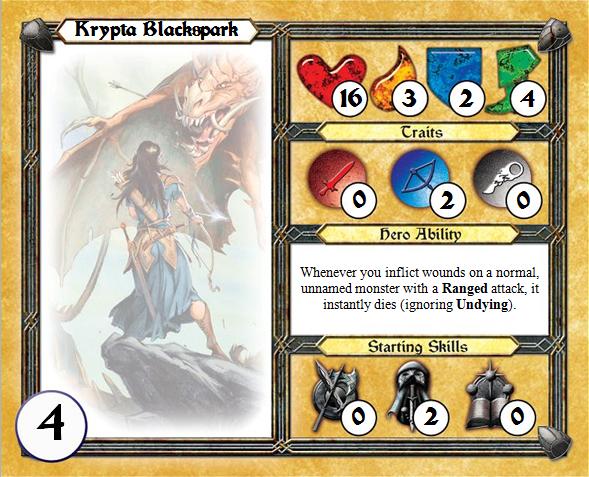
September 26, 2010 - Krypta Blackspark
Naturally, Krypta is suited to sniping normal (white) monsters; she's comparatively weak against master and named monsters, but still strong enough to pose a threat if she's got nothing better to do. She's also slower and tougher than many ranged heroes, lending herself to occupying a central position while making long-range attacks. Krypta may actually want to start the game with a Bow from the shop, as unusual as that is; she still needs to penetrate armor, but doesn't need a lot of damage (against normal monsters), and the range may be a boon for her.
Krypta's ability may seem excessively powerful, but keep in mind that it doesn't work against the targets you'd really like to instagib, and lots of monsters tend to die in one hit anyway. Against tier 1 normal monsters in a 4-hero game, Krypta's attack should have a similar kill percentage to Mad Carthos' attack (he has to inflict 4 wounds to her 1, but gets an extra die and +2 damage); Mad Carthos is strong, but generally accepted as balanced. Krypta really shines when she can snipe high-tier normal monsters, like ogres or dragons, but there are typically only a few of those in any quest, and the overlord can potentially counter with Brilliant Commander. And, naturally, Krypta's ability becomes less important as the heroes acquire stronger weapons.
Hopefully, the end result is that Krypta, like most balanced heroes, feels unusually good when you play to her strengths and handicapped when the overlord exploits her weaknesses, but makes a solid contribution to the party in all games.
I'd say there's an unusually high probability that she's unbalanced in an advanced campaign, though I'll leave it to those who actually play advanced campaigns to judge.
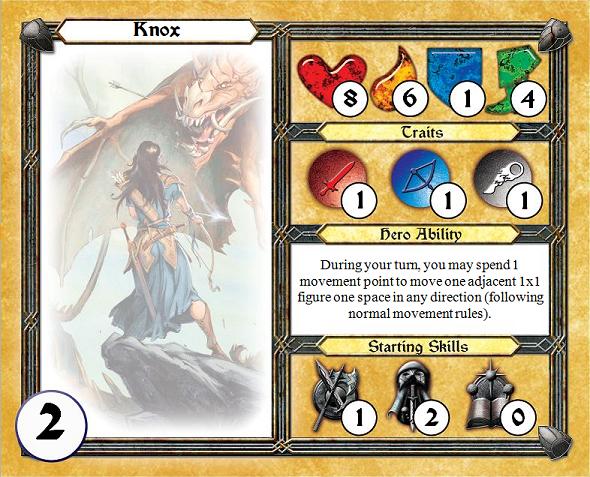
September 19, 2010 - Knox
Knox is a weak attacker, but excellent at running and tactical positioning. His ability can be used to bypass monsters that would get in his way, group enemies for an AoE attack, or boost his allies' mobility (kind of like a limited version of Telekinesis). His excellent fatigue is useful both for sprints and for tactical use of his ability, and also helps make up for his low trait dice by buying more when necessary.
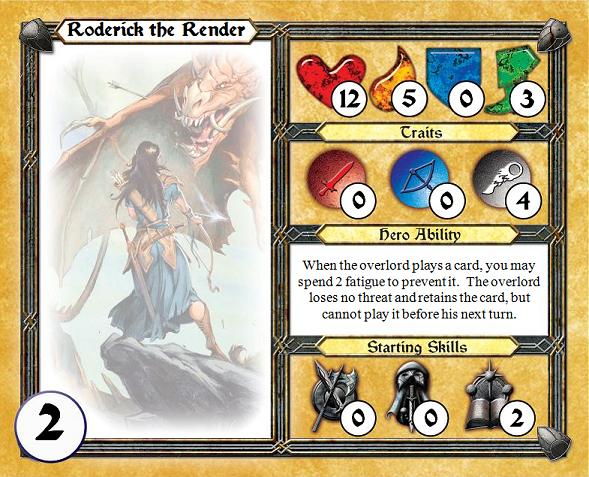
September 12, 2010 - Roderick the Render
Roderick's ability allows him to stop a strategic play by the overlord, such as finishing off a wounded hero with a trap, spawning at a particularly nasty time, or playing a Dark Relic on the last chest of the game. The overlord doesn't lose any cards or threat, so it's only worth using if delaying the card will make it significantly less effective. The best use is probably to spoil a multi-card combo (e.g. spawn + charge), a highly specific set-up (such as Rolling Boulder when the heroes are grouped together and have all taken their turns) or to block a powerful card with a rare triggering condition (such as Dark Relic, or a good chest trap).
Even just the threat of blocking a card may force the overlord to alter his plans, so be sure to keep some fatigue around whenever possible. And don't use the ability too aggressively, or you may be baited into using up your fatigue on a "decoy" card.
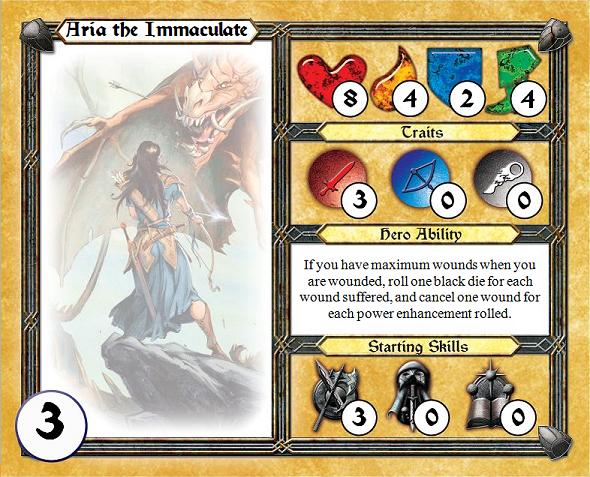
September 5, 2010 - Aria the Immaculate
Having very good defenses while at full health, Aria will want to try to stay that way, and may find herself drinking healing potions more often than most heroes. Picking up a shield will allow her to negate one or two wounds that make it past her primary defenses and help her maintain her aura of invincibility (and she's got enough trait dice to do fine with a one-handed weapon). She may also want to add the Ghost Armor later, if she gets a good light armor as a treasure draw, but I suspect it's not worth it if she would have to downgrade from Chainmail to Leather Armor in order to equip Runes.
As a low-health, high-armor hero, I'd ordinarily say that she's vulnerable to traps, but her ability will defend against those, as well, so perhaps not as vulnerable as one might think. Still, traps have a good chance of puncturing her defenses if she doesn't have the Ghost Armor, so that may be an appealing way for the overlord to open her up to further attack.
Heroes and editor by Jeremy Lennert